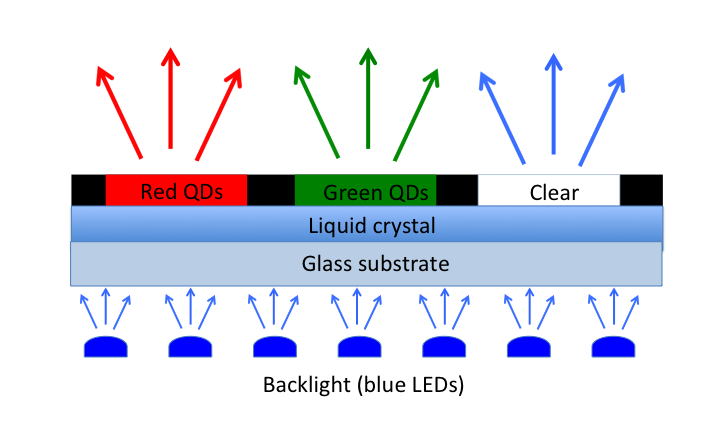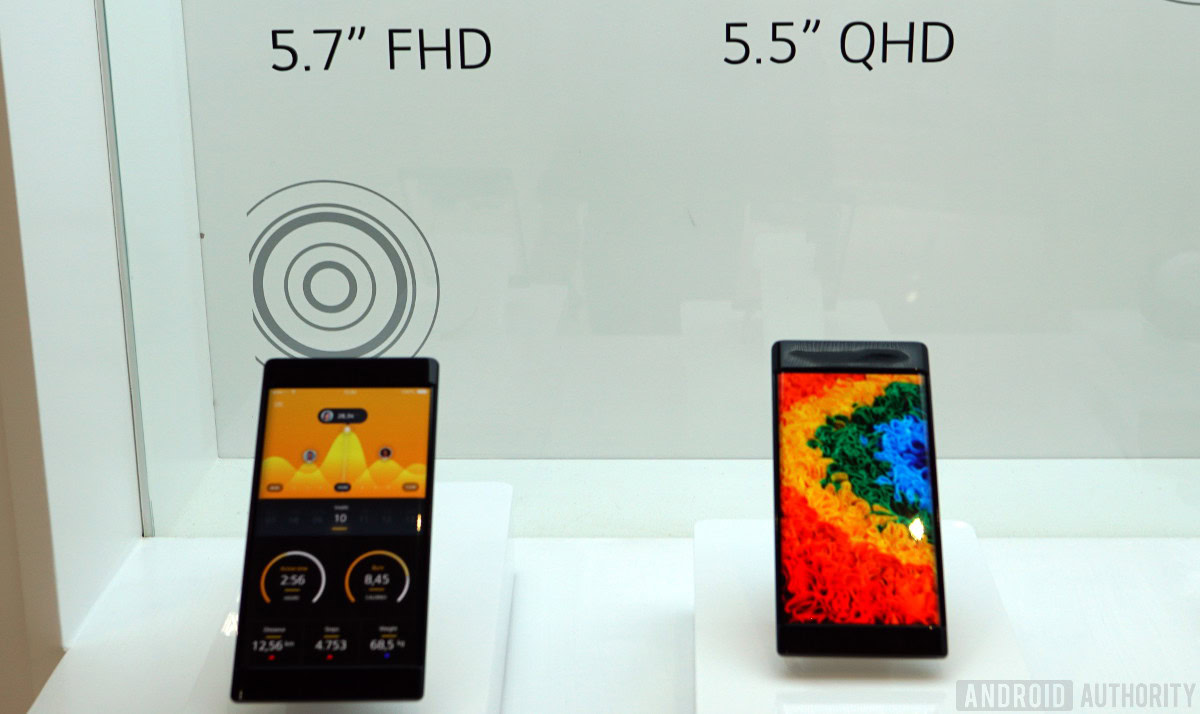 Lawrence Berkeley National Labs
Lawrence Berkeley National Labs
There's a new technology entering the display market, but no one's really noticed it could be the next big revolution. I'm talking about something that could wind up replacing both LCDs and OLEDs as the technology of choice for practically every device currently using either. It's something that has over the past year attracted significant investment from major players in the industry. It's the subject of intense research around the world. The technology I'm speaking of is quantum dots.
Quantum dots could wind up replacing both LCD and OLEDs as the display technology of choice
You've no doubt heard of these little revolutionaries already. A quantum dot (QD) is nothing more than a submicroscopic crystal of semiconductor material (a "nanocrystal"), generally on the order of 10 nanometers (nm) in diameter or smaller. (For comparison, a nanometer — one billionth of a meter — is about the size of ten helium atoms lined up side-by-side.) They're so tiny that they've been referred to as "artificial atoms," since they are atomic-scale particles which in many ways behave like individual atoms.
For display use, they have only certain bound, discrete electron states, which is a quantum physicist's way of saying they can absorb energy and release it only in very limited, specific ways. In particular, they can be engineered to release energy as light in specific wavelengths, and that's where their value lies. Quantum dots can "make light" of very specific (and adjustable!) colors.
That's a big deal for the display industry. If you want to make full-color displays, you need to somehow produce and control light of the three primary colors — red, green, and blue. For LCDs, the usual way of doing that is to provide a "white" (broad-spectrum) backlight, control it via the liquid crystal cells at each pixel, and pass it through color filters to get the desired primaries. There are a couple of things wrong with that.
First, it's inefficient. It makes light that comprises the full spectrum from red to blue, but then throws away two-thirds of that light at each subpixel. Those color filters aren't all that sharp, either. What passes through them is still pretty broadband light, which means that it's not as "pure" in terms of being just the wavelength of the desired color. Less-saturated primaries mean a smaller color gamut for the whole display.
With LCDs, less-saturated primaries mean a smaller color gamut for the whole display. That's where OLED comes in
Of course, we could make the filters better, but that generally means cutting out even more light, which would make the whole display less efficient, drawing more power to achieve the same brightness. Requiring more power isn't a very popular solution in mobile devices. That's where OLEDs came in. Display makers wouldn't be investing huge amounts to make a whole new display technology unless it had some significant advantage, and among the OLED's bag of tricks is the ability to make subpixels which directly emit red, green, and blue light. This makes for an efficient display with a wider gamut than the LCD alternative.

Quantum Dots vs. OLEDs
The LCD camp wasn't going to give up the market without a fight, of course. One of the weapons used to counter the OLED threat has been quantum dots. Originally, the technology was brought in as a backlight enhancement. Rather than lighting LCDs with "white" LEDs (actually blue emitters with a yellow phosphor coating), a quantum-dot backlight design uses plain blue LEDs (which are less expensive) and adds red- and green-emitting QDs to convert the blue light into the other two primaries. The dots could be contained in a separate component, between the blue LEDs and the rest of the backlight.
Some designs used a plastic rod in which the quantum dots were embedded, and placed it between the LED strip and the backlight structure. Others — typically larger displays, like those intended for laptops, monitors, or TVs — would put those same dots into a film that would then be inserted with the rest of the backlight's film stack. Either way, the result was a more efficient display with a wider gamut.
Quantum Dot designs are a very serious challenge to the supposed performance superiority of OLED displays
However, these displays still rely on color filters to separate the red, green, and blue light before it reaches the viewer. The next logical step was to get rid of the old-style color filters and replace them with a patterned QD layer.
Instead of "white" light coming through the backlight, the LCD subpixels would all be controlling regular blue light. The red and green subpixels both have "filters" of the appropriate-colored quantum dots, which convert the blue light as the last step before sending it on to the viewer. The blue subpixels simply don't require a color filter.

Using quantum dots as color filters
This makes for a significant improvement in efficiency, as well as improving the viewing angle and contrast of the display, all while improving the color-gamut. These "QDCF" designs are a very serious challenge to the supposed performance superiority of OLED displays. Quantum dots also don't suffer at all from the "burn-in" problems (including different rates of aging across the three colors) of OLED technology.
Electro-emissive, or electroluminescent, Quantum Dots are the real potential game-changer
Quantum dots vs. micro LEDs
This isn't the last step in QD display technology, though. While quantum-dot color filter screens are already coming to market, another advancement is waiting in the development labs: the QD version of the so-called "micro-LED" display. We've talked about the future of inorganic LEDs in displays before, but quantum dots can take that game to a whole new level. Up to now, we've only been talking about the photoemissive behaviors of QDs — how they can emit light after being excited by another light source. Quantum dots can also exhibit electro-emissive properties, in which they emit light directly in response to an electric field.

Micro LEDs may be the next target for quantum dot technology
Electro-emissive or "electroluminescent" QDs are the real potential game-changer. A display using quantum dots in this manner would eliminate the liquid-crystal layer completely, and instead directly excite the dots to produce red, green, and blue light at each subpixel location. This would make for a display with the response time, viewing angle and contrast of an OLED, with even better efficiency. It could also be a good deal easier to produce than the current plans for micro-LED screens. Unlike inorganic micro-LEDs, electro-emissive quantum dots are processed and patterned as liquids, like how color filter layers and similar display structures are produced today.
High efficiency, better viewing angles and contrast, a wide color gamut, microsecond response times, and easy processing — what's not to like? There is at least one negative in QD technology, though: the nature of the materials themselves. Quantum dots are most commonly made from compounds containing lead, selenium, and especially cadmium, all of which pose known health risks.
High efficiency, viewing angles, and contrast, a wide color gamut, microsecond response times, and easy processing — what's not to like?
Under some conditions, quantum-dot materials are known to break down and release these elements. This has raised concerns about their potential use in consumer products and drawn the attention of various regulatory agencies. However, varieties of quantum dots without such substances have been developed, including recent demonstrations of carbon-based QDs. There continues to be a great deal of work done on making all varieties safer to use.

The future of quantum dots in displays
All in all, it's very likely that quantum-dot technology will grow rapidly in the display market. Samsung especially has been making very strong moves in this area, purchasing the intellectual property of Boston-area startup QD Vision in late 2016. Through the past year, the company has heavily promoted what it calls "QLED" technology in its product lines. (This name is, of course, confusingly similar to "OLED." Like the use of "LED display" before it, it ignores that the underlying tech is still the good old LCD. How they'll distinguish future "pure QD" displays is anyone's guess.) But Samsung isn't the only company getting into this space.
It wouldn't be at all surprising if quantum-dot displays — both LCD-based and those using QDs as basic emissive elements — become dominant across the electronic display industry in relatively short order. It's actually quite possible that OLEDs, once hailed as the next big technology, could be bypassed without ever getting close to a majority share in the market.
Truly, a quantum leap for the industry.
from Android Authority http://ift.tt/2FyyE1J
via IFTTT

0 Response to "The next quantum (dot) leap for displays"
Post a Comment